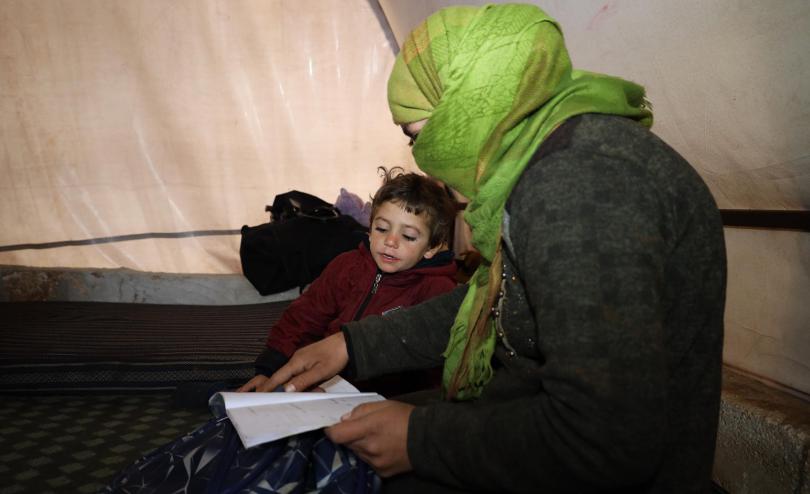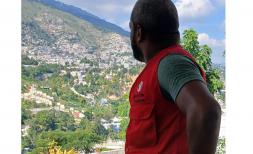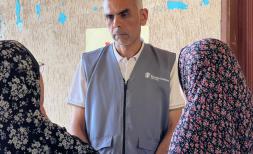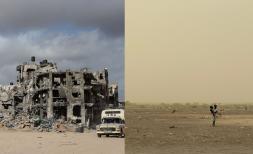Weam*, 8 and his mother Feryal* in a tent reading a book together. Hand in Hand / Save The Children.
This story was originally published by The New Humanitarian.
Thirteen years since the conflict in my home of Syria began, the country bears little resemblance to the place where I grew up. The protracted conflict has also skewed the way the world – and those who fund humanitarian assistance in Syria – see the country, preventing aid workers like me from providing the kind of help that millions of people need.
{cta | By giving to Save the Children today, you can help <span class="text-primary">protect a child’s life and future</span>. | https://donate.savethechildren.org/en/donate/what-would-you-save/ | Donate now
More people need humanitarian assistance in the country than ever before during the war. This figure of 16.7 million, nearly 80% of the population, is rising, and what people need is shifting. But the aid system I work in refuses to change: It remains a Band-Aid on a gaping wound, offering temporary relief without addressing root causes. And these days, given severe funding shortages and the sheer scale of need, we are not even able to offer Band-Aids.
A few weeks ago, my colleagues in Syria told me about a group of children they had just met, who were retaking the sixth grade, over and over again: not because they weren’t learning or passing their exams, but because they don’t have access to secondary education, and their options are to stay in the same school or work, at a young age. These children are trapped in a failing education system, and the aid sector is not set up to help them.
Growing up in Syria, my childhood was far from this bleak reality. My father, a doctor, was able to send us to school and provide us with a comfortable home. Today, a doctor's monthly salary in Damascus is equivalent to $26, which is barely enough to cover the cost of transportation to and from work.
The landscape of aid work in Syria is also undeniably entangled with political complexities and economic realities. Major donors have stipulated that political change in Syria is necessary if they are to fund reconstruction or development aid, at the same time as they are less willing to give money at all.
This means that without any momentum towards genuine peace, aid workers and the people we serve are stuck in a cycle. We can’t provide anything other than “light touch rehabilitation” to destroyed homes, instead of the substantial repairs that are truly needed.
But there is a place between emergency relief and full-fledged reconstruction, and that place is early recovery. This isn’t about supporting one side of the war or another. It is about making sure that children are safe, that they have access to basic services, and that they can live with some sort of dignity and respect wherever they are in the country, regardless of who controls the part of Syria they live in.
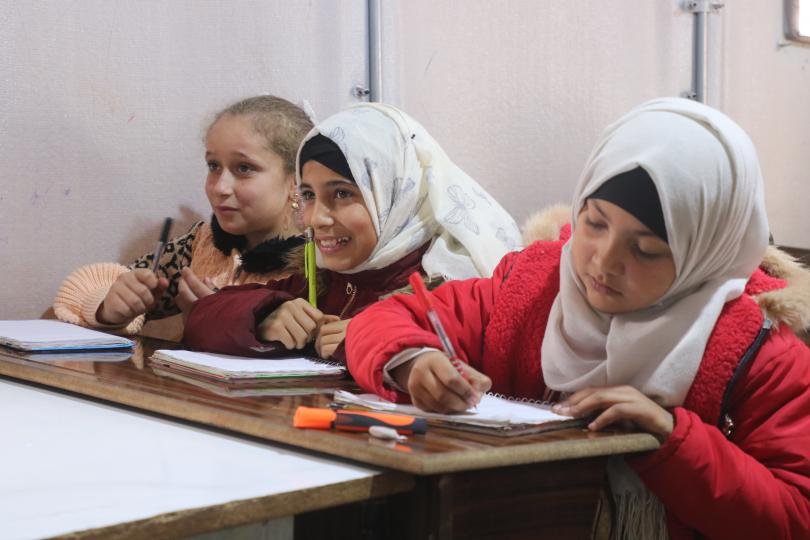
Marah* (11) smiling during a lesson in school with her friends Nour (12) and Niveen (12). Bonyan / Save The Children
Early recovery
For years, Save the Children, alongside other aid organisations, has advocated for increased investment in “early recovery” efforts in Syria, even though it has become caught up in the political conversation about “reconstruction.”
This is a type of aid that is defined as “humanitarian” and not “development,” prioritising sustainable solutions that empower communities to help themselves, and foster resilience. Like teacher training or supporting communities to repair playgrounds and schools. That is what early recovery is supposed to do.
But so much of the time, we can’t even do this. The sad reality is that Syria’s conflict is far from over. Since last October, dozens of people have been killed and at least 120,000 forcibly displaced by violence, in the most significant escalation in years.
For early recovery to work, basic infrastructure needs to be in place, giving us something to build off. It relies on an electricity grid, piped water, and functioning markets. But for more than a decade now, Syrians have endured declining basic services. Damage to power stations, coupled with fuel shortages for those still functional, have plunged entire cities and villages into prolonged blackouts. In some areas, households are lucky if they have electricity for more than 30 minutes per day.
We are watching the basic elements of a successful early recovery, and a future transition into development, collapse around us. Syrians are in economic freefall, with 90% of people struggling to buy essentials.
I am watching this, and experiencing this, as one of the 13 million Syrians who were forced or chose to leave over the last 13 years, becoming refugees or displaced people. My phone is regularly flooded with heartbreaking requests from relatives or friends-of-friends struggling back home.
Even those not caught up in the violence are being squeezed by the economic crisis, with aid workers sending photos of empty refrigerators, while parents are making the difficult choice to send children on perilous journeys across the Mediterranean Sea to make it to Europe.
Time for a change
There are moments when Syria’s unresolved political situation, and the way it impacts aid, are far too clear.
Last year, when earthquakes hit southern Türkiye and northern Syria, killing more than 56,000 people, the international community was slow to respond in Syria. During the subsequent pledging conference asking for donors to chip in, the language used reflected very distinct priorities.
For Türkiye, the emphasis was on rebuilding infrastructure, ensuring fully functional hospitals, and creating job opportunities to enable affected individuals to rebuild their lives and support their families.
In contrast, the discussion regarding Syria highlighted the fact that the earthquake had exacerbated an existing humanitarian crisis, underscoring the already urgent need for funding. There was no talk of rebuilding, or even helping people get back on their feet. There wasn’t much discussion of early recovery, either.
Saleh* 15, wearing his crutches and holding a Choose Love drawing, Syria.Hand in Hand / Save The Children.
Beyond the jargon, this matters to real families. Thousands of children, like 15-year-old Saleh, who have never known Syria beyond the conflict. His family was uprooted to a camp after his father died, and some of my colleagues met him this winter.
“I’ve [also] lost my sister, uncle and grandfather,” said Saleh, whose real name and location are not being published for his security.
He’s recovering from a bullet wound to his leg and dreams of becoming a doctor despite the slim educational pathways inside the camp. Kids like Saleh just want the things that they know children in other places have.
They want safe schools, with trained and paid teachers. If they get sick, they want to be able to go to a hospital with the right equipment and medicine to diagnose and treat them. They want their parents to have jobs that mean they can eat three meals a day, drink clean water, and heat their homes during the winter. In short, they want to be allowed to be children.
If we do not start to do genuine early recovery, we are setting up a lifetime of aid dependency, of increased risk of insecurity and violence, malnutrition, early marriage, child labour, leaving migration as one of the few options available.
The future
Some headway has been made in ensuring that donors and others know what early recovery is, what humanitarians want to do, and why it matters to children.
More donors are funding these activities, and the UN is working on a strategy that could – if it is genuinely inclusive – offer a real chance to collaborate with local communities, test out new ways of working, and do things differently.
But for this to work, we must make it clear to all sides in the war that attacking vital civilian infrastructure is unacceptable, and recommit to supporting a meaningful, inclusive peace process that allows Syrians to determine their own future.
They must do more to foster a space that is conducive for early recovery.
This means ensuring that sanctions, restrictions on exports, and counter-terrorism legislation do not limit our ability to do more. It means listening to UN experts and others who have warned, even before the earthquake, that sanctions are having a negative impact on economic recovery in all of Syria. This has the effect of collectively punishing the population.
As Syria enters its 14th year of conflict, the world is a polarised place. More conflict and climate change are likely to bring fresh displacement, and make global resources even more scant.
As a Syrian humanitarian, I do not want to plead year after year for a piece of a diminishing pot of funding. I do not want to beg to ensure that people are piped in clean water, or that hospitals have basic equipment, as the country collapses around me. I can’t ignore the fact that without a genuine transformation of our approach to Syria, we are condemning an entire country to live in aid dependency.
Tents in a displacement camp in Syria. Hand in Hand / Save The Children
We need to stop debating terminology and stop allowing politics to dictate what support Syrians are “allowed” to have from the international community.
I don’t live in Syria anymore, and last year, I took my five-year-old son to my beloved hometown, Damascus. He looked around and said: “Syria is the worst country in the world. How can people live without electricity?” I had no answer. How can I explain the politics of the aid system today to him? Somehow, I hold on to the hope that someday he will come to appreciate this place as much as I do.
Syrians are running out of patience and running out of options. I am tired of having no good answer. While we wait for peace, humanitarians owe our children a better way of working, and the international community owes them a future.
-----
Rasha Muhrez is a professional humanitarian with over 16 years in senior and leadership roles with International NGOs. Rasha has spent most of her career working in Africa and the Middle East in complex emergencies and countries in transition. Including, Syria, Yemen, Niger, Sudan and South Sudan. In December she joined Save the Children as Syria Response Director to lead one of the world’s most complex humanitarian operations.
Rasha holds a BSc in Economics from Damascus University, an MBA from Université Paris-Dauphine and an MBA for Executives from the Higher Institute of Business Administration in Damascus. She is passionate about the work she is doing with Save the Children and committed to be the voice for those who are most vulnerable and deprived of their rights.
-----
The New Humanitarian puts quality, independent journalism at the service of the millions of people affected by humanitarian crises around the world. Find out more at www.thenewhumanitarian.org.
